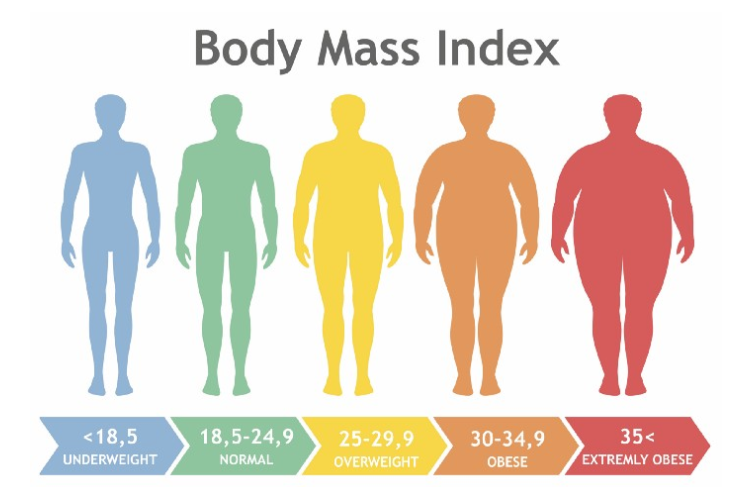I believe that many listeners have heard of the concept of body fat percentage, and even some friends are paying close attention to their body fat percentage changes every day. But do you really know what body fat percentage is? What does it represent? Let me tell you.
Body fat percentage, also known as body fat percentage, refers to the percentage of body fat you have as a percentage of your total body weight. Body fat percentage indicates how much fat you have in your body. This value directly indicates whether you are obese or not, and is directly proportional to the risk of high blood pressure, high blood sugar, and high blood lipids. Hearing this, listeners may understand the role of body fat percentage.
Is a lower body fat percentage better? Of course not. Scientifically speaking, there are many beauty-loving women or dieters who are happy to reduce their body fat percentage to very low levels through diet or other means. This is not true. Everyone has a certain range of body fat percentage, and neither too high nor too low is good. Generally speaking, except for professional athletes and professional bodybuilders, people with low body fat percentage are advised to increase their diet in order to increase their body fat percentage. Why is that? Doesn’t a low body fat percentage mean good health?
This brings us to the important role of body fat. Most of the time, people are concerned about their own or their family’s health and avoid fat in the family diet, thinking it’s a bad guy. In fact, the body needs a certain amount of fat. Why is that?
This is because fat is an important part of the body, it is divided into lipids and neutral fats. Among them, lipids, including phospholipids and cholesterol, are important components of our cell membrane, and are indispensable substances for forming new tissues and repairing old ones, regulating metabolism and synthesizing hormones.
Neutral fats, also known as triglycerides, are found under the skin, in the abdominal cavity, around the organs, and in the space between bones and muscles. Most neutral fats act as energy providers in the human body, with a strong function of energy storage and supply, and are the main way of energy supply when people lack energy and suffer from hypoglycemia.
At the same time, the fat evenly distributed in all parts of the body shoulders the responsibility of protecting the body, such as regulating the body temperature and preventing heat loss; The fat that surrounds the internal organs also holds and protects them, and acts as a buffer.
In addition, fat has the unexpected effect of promoting the absorption of fat-soluble vitamins such as A, D, E and K. So when we restrict the intake of fat, it will lead to the human body due to lack of certain vitamins and appear a variety of diseases. For example: vitamin A deficiency caused by night blindness, dry eye, poor vision; Bone and tooth dysplasia caused by vitamin D deficiency; Vitamin E, K deficiency caused by low immunity and so on.
One last thing I don’t need to tell you is that fat increases your appetite. I believe that most of our listeners share my obsession with meat products.
At this point, some listeners may want to say: are we wrong about fat? Fat is a good thing, and we need more of it! This certainly isn’t. There are also bad fats in the body — they’re called saturated fatty acids. Long-term excessive intake can easily induce obesity, hypertension, diabetes and cardiovascular and cerebrovascular diseases. But don’t worry, as long as we supplement the diet with a certain amount of unsaturated fatty acids, such as cooking with vegetable oil, can effectively reduce the risk of these diseases, also can prevent hyperlipidemia and Alzheimer’s disease. So having too much fat or too little fat is not good for you.
So how do we determine how much fat we have? This brings up two issues — body fat percentage and how to know your body fat percentage. Let’s start with body fat percentage. It’s not a fixed number, it’s a range, and it varies between men and women. The normal range of body fat for adults is 15 to 20 percent for men and 20 to 25 percent for women, and once the upper range is exceeded, people are considered overweight or obese.
So how do we know our body fat percentage or that of our family? The best way is to go to the hospital, through certain equipment for body fat detection, so that you can get more accurate body fat percentage data and targeted doctor’s advice. However, this approach is too tedious and takes time and experience. Therefore, it is important to find a suitable alternative to body fat percentage to determine if you are overweight or obese when you cannot accurately measure your body fat percentage at home. Now let’s look at two simple methods.
The first method is called body mass index, or BMI, and it works by dividing your weight by your height squared. At this point, I suggest that you open the calculator on your phone and calculate your BMI according to the formula. Our overweight BMI critical value is set as 24, the obesity boundary value is set as 28. In other words, if your current number is greater than 24, you’re basically overweight. If the number is already greater than 28, take note! You are already obese. Of course, anything below 18.5 is considered thin and bad for your health.
If you don’t think BMI is enough, or if you want to be sure, you can try the second method — measuring waist and hip circumference. Waist circumference is an important indicator for the diagnosis of central obesity, and its value is closely related to a variety of chronic metabolic diseases. Obesity was defined as waist circumference greater than 85 cm for men and 80 cm for women.
After we have measured the waist circumference and hip circumference, we can divide the waist circumference by the hip circumference to get a value called the waist-hip ratio. A waist-to-hip ratio greater than 0.9 for men and 0.85 for women can also be defined as obesity. These two methods can give a rough estimate of your obesity level, but they are not suitable for professional athletes and professional bodybuilders.
Now assume that you have known your body fat content through simple calculation and measurement, if this value is not in the range of body fat percentage given in front, we should pay attention! If your BMI is low, it is recommended that you do not continue to lose weight through diet, but gradually increase the proportion of meat and dairy products in your diet and appropriately increase strength training. If your BMI is too high, it is recommended that you develop a suitable exercise training plan under the guidance of a professional, reduce the intake of sugar and fat in your diet, and slowly reduce your BMI to a normal range.
In addition to the introduction of a point of view: we usually in the weight loss should say more fat, rather than weight. Because it’s not excess weight that affects our bodies, it’s having too much body fat. If our weight is caused by excess fat, we need to exercise and diet to reduce body fat; If our weight is caused by more muscle, we don’t need to lose too much weight. Even in the process of losing weight, the weight does not fall or even slightly rise, as long as the body fat percentage drops are beneficial to health.
In short, as one of the indicators to judge whether the human body is healthy, the lower is not the better. We should correctly understand the important role of body fat, through diet and exercise to control the percentage of body fat in the normal range, to achieve a healthy goal. Hope THE AUDIENCE friends do not forget their choice of exercise fitness is to obtain a healthy body, do not overly extreme pursuit of low body fat rate, let the body suffer damage.








Recent Comments